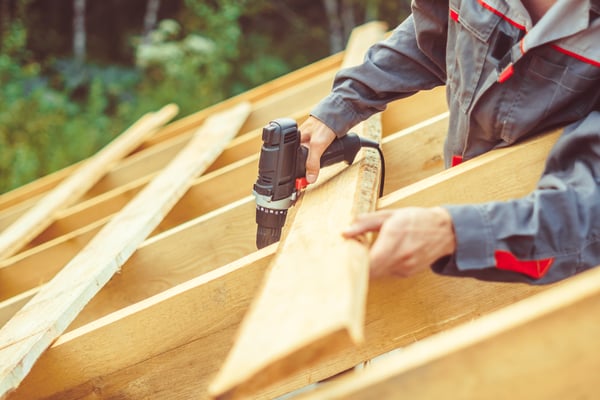Wood: A Sustainable Construction Material

Environmental sustainability has become a global concern. Countries and corporations are becoming more aware of the damage they cause, and are looking for ways to mitigate the harm. Construction procedures and materials can harm the environment, and this has spurred an interest in developing environmentally friendly techniques and materials.
Individuals, companies and governments are striving to improve the environmental performance of their buildings and the materials used. Buildings represent 35-40% of US energy consumption and a similar percentage of the national carbon emissions. Green construction is key for sustainability and to mitigate environmental damage.
Implement green construction methods in your next building project.
Wood is a renewable resource that can contribute to sustainability in the construction industry. It may be difficult to think of wood as a sustainable material, since it is associated with deforestation. However, man-made construction materials like concrete and steel have a huge carbon footprint, causing even more damage to the environment. Using wood instead of steel or concrete reduces environmental impact, as well as construction and operation costs.
Advances in building technology allow the use of wood in a wide range of non-residential, multi-story and long-span buildings. Construction codes have been evolving accordingly, to accommodate wood construction methods.
Wood as a Construction Material
Wood is a versatile organic material, and the only renewable construction material. Wooden structures have certain properties that make them durable and strong. With an adequate fire retardant treatment, wood can be a reliable construction material with a long service life.
Benefits of Wood
Thermal Properties: Wood does not experience a major expansion with heat. Also, the combination of low thermal conductivity and high specific heat provides insulation
Acoustic Properties: Wood can amplify or mitigate sound based on its orientation. Sound is transmitted along the grain direction, and mitigated in the perpendicular direction.
Electrical Properties: Dry wood is an excellent electrical insulator and it does not accumulate static electricity. However, note that the electrical resistance of wood is inversely proportional to its moisture content
Mechanical Properties: Wood has a high strength and durability. It also has a high breaking length - the length at which a material breaks under its own weight when hanging.

Aesthetic Properties:Wood is considered cozy, rustic and decorative. It also offers variety in color, shape, smell, and texture. Wood can be painted to achieve the desired finishes. With this kind of versatility, this material is also a great choice for building outdoor furniture for your home's interior. If you're a DIY enthusiast, you can build simple wood projects, whether for decor or practical use.
Maintenance: Wood doesn’t rust like metals, and it can be repaired and maintained. Old wood can be restored, although the operation can be costly
Variety: There are more than 5000 species of wood, and the properties mentioned above vary for each type.
Understanding the Limitations of Wood
Wood has limitations like any construction material, but these can be mitigated with several protection methods. Ideally, wood should be used in products that take advantage of its benefits, and where its limitations are not major issues.
Shrinkage and Swelling: Wood is hygroscopic, which means it absorbs moisture from the air. This causes wood to shrink and swell.
Biotic deterioration: Since wood is an organic material, it is food for some plants and animals. Biological deterioration can occur from the attack of fungi, termites, beetles, ants, etc.
Abiotic deterioration: Non-biological deterioration of wood can be caused by the sun, wind, water, chemicals and fire. Using thick wood as a structural element can help mitigate deterioration.
Wood Protection Methods to Improve Performance
Selecting the right type of wood according to project conditions is key, making sure it will perform properly. The main techniques to protect wood include drying, coating and impregnation. These can help eliminate the main limitations of the material.
Coating:
- Provides protection for both indoor and outdoor applications
- Prevents rapid uptake and loss of moisture
- Reduces shrinkage and swelling
- Some coatings protect wood from ultraviolet rays
- Fungicides can be added to coatings
Drying: Drying can prevent the degradation of wood, and it is typically dried with air or a kiln. The kiln drying method is more effective because it kills fungi and insects, while removing moisture more effectively.
Wood Preservatives: These are used in situations where wood will be constantly exposed to liquids, insects and weather.
Flame Retardants: It is impossible to make wood non-combustible, but it can be treated with flame retardants. The two retardant types used for wood are coatings and chemical water soluble salts. They increase the burning point, reduce the formation of flammable gases, and mitigate the spreading and penetration of flames.
Wood as a Green Product
Renewable
Unlike other building materials like concrete and steel, wood is renewable. It can be grown and harvested multiple times.
Reduce, Reuse, and Recycle
Wood waste products can be recycled and transformed into new products. Also, innovative designs can optimize the usage of materials to reduce waste.
Carbon Footprint
The manufacturing processes of steel and concrete release carbon dioxide to the environment, also transportation also adds to the carbon emissions. Wood harvested from sustainably-managed forests has a smaller carbon footprint, and trees absorb carbon dioxide during photosynthesis
Forest Certification
Look for certified wood to ensure that it comes from sustainable forests. This helps enforce forestry practices among consumers and retailers, eliminating destructive lumbering practices.
Nearby EngineersNew York Engineers has a MEP design track record of 1,000+ projects. Contact us via email (info@ny-engineers.com) or phone (786) 788-0295212-575-5300, and make sure your building systems meet codes.

Ravindra Ambegaonkar
Ravindra, the Marketing Manager at NY Engineers, holds an MBA from Staffordshire University and has helped us grow as a leading MEP engineering firm in the USA
Join 15,000+ Fellow Architects and Contractors
Get expert engineering tips straight to your inbox. Subscribe to the NY Engineers Blog below.

